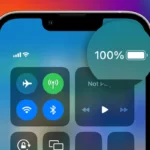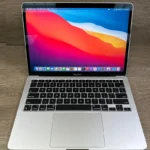Is your MacBook making three beeps when you try to turn it on? This sound is a warning sign that something is wrong with your computer. When your Mac beeps three times at startup, it usually indicates a memory (RAM) problem or firmware issue that needs to be fixed before your computer can work properly.
Don’t worry if this happens to you. Many Mac users face this problem, and there are several simple solutions you can try at home before taking your computer to a repair shop. The fix might be as easy as resetting your Mac’s NVRAM or checking the power source.
Knowing what causes these beeps can save you time and money. The three-beep pattern is Apple’s way of telling you what’s wrong, and once you understand the message, you can take the right steps to get your Mac running again.
What Does It Mean When Your MacBook Beeps Three Times?
If your MacBook beeps three times during startup, it’s signaling a hardware-related issue, most commonly with memory (RAM) or firmware.
According to Apple Support, a repeating three-beep pattern during startup usually means that your Mac’s RAM has failed a system integrity check or is incompatible with the logic board (Apple Support).
🔊 Beep Pattern Breakdown:
- 3 beeps, repeating every 5 seconds: RAM failure or undetected memory.
- 3 long, 3 short, 3 long: Firmware corruption (rare).
🧠 Common Causes
- Faulty or improperly seated RAM (common in older MacBooks with removable memory).
- Incompatible memory modules — especially if RAM was recently upgraded.
- Firmware corruption or failed update.
- Motherboard or logic board issue (less common, but possible).
(Sources: Apple Support, iBoysoft, MacMyths)
🧩 Step-by-Step Troubleshooting Guide
Step 1: Identify Your Mac Model
- Click the Apple menu → About This Mac (if it boots).
- If it doesn’t start up, check your MacBook’s serial number on the bottom case or packaging, then look it up on Apple’s Check Coverage page.
Step 2: Perform a Power Reset
- Shut down your Mac completely.
- Unplug the power adapter.
- Hold the power button for 10 seconds.
- Reconnect power and try starting up again.
If the beeping continues, move to the next step.
Step 3: Reseat or Replace RAM (for older MacBooks)
⚠️ Note: This applies only to pre-2016 MacBook Pro/Air models with removable RAM.
- Power off your Mac and disconnect all cables.
- Remove the bottom case using a small Phillips screwdriver.
- Carefully remove and reinsert the RAM sticks.
- Ensure they’re seated firmly in their slots.
- Reassemble and power on your Mac.
If the beeping persists:
- Try using one RAM stick at a time to identify the faulty one.
- Replace the RAM with Apple-approved memory.
(Detailed steps: MacMyths Guide)
Step 4: Reset NVRAM and SMC
If your Mac has soldered RAM (non-removable), try these resets:
🔹 Reset NVRAM:
- Turn off your Mac.
- Turn it on and immediately hold Option + Command + P + R.
- Keep holding for ~20 seconds, then release.
🔹 Reset SMC (Intel Macs only):
- Shut down your Mac.
- Hold Shift + Control + Option + Power for 10 seconds.
- Release all keys, then press Power again to start.
Step 5: Run Apple Diagnostics
- Disconnect all external devices except keyboard and power.
- Turn on your Mac and hold D immediately.
- Wait for Apple Diagnostics to load.
- Note any error codes (e.g., PPM002, PPM003 = RAM issues).
More info: Use Apple Diagnostics to test your Mac
Step 6: Reinstall macOS or Update Firmware
If diagnostics show no hardware issue but the beeping persists:
- Boot into macOS Recovery (hold Command + R during startup).
- Choose Reinstall macOS.
- If firmware corruption is suspected, reinstalling macOS can refresh it.
Step 7: Contact Apple Support
If none of the above works, your Mac may have a logic board or soldered RAM issue that requires professional repair.
Contact Apple or visit an Apple Authorized Service Provider:
👉 Apple Support Contact Page
🧾 Summary Table
| Beep Pattern | Meaning | Fix |
|---|---|---|
| 3 short beeps (repeat) | RAM not detected or failed | Reseat or replace memory |
| 3 long, 3 short, 3 long | Firmware corruption | Reinstall macOS or contact support |
| No beeps, black screen | Power or logic board issue | Reset SMC / seek service |
💡 Pro Tips
- Always use Apple-certified RAM for upgrades.
- Keep your macOS updated to avoid firmware conflicts.
- Avoid static discharge when handling internal components.
- If your Mac is under warranty or AppleCare, do not open it yourself — contact Apple first.
In short:
Three startup beeps on a MacBook almost always point to a RAM or firmware issue. Start with a power reset, then reseat or replace memory if possible. If your model has non-removable RAM, try NVRAM/SMC resets and Apple Diagnostics before seeking professional help.
Key Takeaways
- Three beeps at startup point to RAM or firmware problems that often have simple fixes.
- Resetting NVRAM by holding down Option, Command, P, and R keys for 20 seconds can fix many beeping issues.
- Check your power source and connections before assuming you need costly repairs.
Understanding the Beeping Signal
When your Mac makes beeping sounds at startup, it’s trying to tell you something important about hardware problems. These sounds are part of a diagnostic system that helps identify what’s wrong with your computer.
Deciphering the 3 Beeps
The pattern of three beeps during startup is a specific error code from your Mac. This sound typically points to RAM (Random Access Memory) issues. When your Mac can’t properly access or use its memory, it can’t boot up normally.
RAM problems can happen for several reasons:
- Loose memory modules
- Damaged memory slots
- Faulty RAM sticks
- Incompatible RAM installed
To fix a Mac beeping three times, first try resetting the SMC (System Management Controller). If that doesn’t work, the RAM might need reseating. Gently remove and reinsert the memory modules.
Some Mac models have soldered RAM that users can’t access. These computers need professional repair if the beeping continues.
The Role of BIOS and POST
The beeping happens during the POST (Power-On Self Test) process. This test runs before your operating system starts. It checks if all hardware components work properly.
Your Mac’s firmware (similar to BIOS in Windows computers) controls this test. When the Mac beeps during startup, the firmware has found a problem serious enough to prevent normal boot.
Different beep patterns signal different problems:
- Three beeps: RAM failure
- Two beeps: No RAM installed
- Five beeps: Processor failure
On newer Macs, you may notice a pattern of three long beeps, three short, then three long. This indicates the Mac is restoring firmware and may show a progress bar.
The startup sound (or lack of it) can also provide clues about your Mac’s condition.
Common Causes of the Beeping Sound
When a MacBook produces three beeps at startup, it typically signals hardware or firmware issues that prevent normal operation. These warning sounds are part of the Mac’s built-in diagnostic system.
RAM Module Issues
RAM problems are the most common reason for the three-beep error code. The beeping often indicates that the RAM hasn’t been properly inserted or has become loose over time. This can happen after moving your MacBook or if it has experienced a physical shock.
Sometimes the RAM modules might be incompatible with your MacBook model. Your RAM must have the correct type and speed for your specific MacBook. Using the wrong RAM specifications can trigger the error.
Physical damage to RAM modules can also cause this issue. Damaged pins, corrosion, or dust buildup on the connectors might prevent proper communication between the RAM and the motherboard.
Common RAM issues that trigger beeping:
- Loose RAM modules
- Incompatible RAM type
- Dust or debris on connectors
- Physical damage to modules
Firmware Complications
Firmware issues represent another significant cause of the three-beep problem. When a Mac beeps three times, it might indicate that the operating system is incompatible with your hardware or that the system can’t recognize the installed RAM.
Failed firmware updates can lead to this error. If a firmware update was interrupted or didn’t install properly, it might cause startup problems that trigger the beeping sound.
Boot ROM issues can also result in the three-beep error. The Boot ROM is essential for the initial startup process, and any corruption can prevent your Mac from booting normally.
Warning signs of firmware problems:
- Mac won’t complete startup
- Screen remains black with only beeping sounds
- Multiple failed restart attempts
- Recent interrupted updates
Power Supply Problems
Power-related issues may also trigger the three-beep warning. Insufficient power during startup can prevent proper initialization of RAM and other components.
Battery problems in MacBooks can cause startup failures. If the battery is failing or completely dead, it might not provide enough consistent power for normal operation, resulting in the beeping error.
Power surges or unstable electricity can damage internal components. This damage might not be immediately visible but can affect how your MacBook communicates with its RAM.
MacBooks with damaged power management units (PMU) often exhibit startup problems. The PMU controls power distribution throughout the system, and when it malfunctions, it can trigger various error codes including the three beeps.
Power issues to check:
- Battery health and charge level
- Power adapter functionality
- Recent power surges
- Loose power connections
Troubleshooting the Beeping MacBook
When your MacBook starts up with three beeps, it’s typically signaling a memory or firmware issue that needs immediate attention. These beeps are part of Apple’s built-in diagnostic system that helps identify hardware problems before the computer fully boots.
Initial Steps and Checks
First, shut down your MacBook completely. Disconnect all external devices including USB drives, external monitors, and peripherals. These connections can sometimes interfere with the startup process.
Try a simple restart by holding the power button for 10 seconds, then pressing it again to turn on your Mac. If the beeping continues, perform a power cycle by unplugging the power adapter, removing the battery (if possible on older models), waiting 30 seconds, then reconnecting everything.
Check for physical damage or recent impacts that might have affected internal components. Sometimes, even a minor bump can dislodge RAM modules.
Make sure your Mac is on a flat, cool surface. Overheating can sometimes trigger similar symptoms, though typically not the three-beep error.
Testing RAM Modules
The three beeps you hear usually indicate a memory (RAM) issue in your MacBook. RAM modules might be:
- Loose in their slots
- Damaged or failing
- Incompatible with your system
For MacBooks with accessible RAM (pre-2012 models mostly), try these steps:
- Shut down and unplug your MacBook
- Remove the bottom case following your model’s instructions
- Locate the RAM modules
- Carefully remove and reseat each module, ensuring they click firmly into place
- Try booting with one RAM module at a time to identify if one is faulty
For newer MacBooks with soldered RAM, professional service is recommended as DIY repairs aren’t possible.
Resetting the System Management Controller (SMC)
An SMC reset can often fix firmware issues that cause startup problems. The SMC controls many low-level functions in your Mac.
For MacBooks with non-removable batteries (most models after 2009):
- Shut down your MacBook
- Connect the power adapter
- Press and hold Shift+Control+Option and the power button together for 10 seconds
- Release all keys and power button simultaneously
- Press the power button to turn on your Mac
For older MacBooks with removable batteries:
- Shut down and remove the battery
- Disconnect the power adapter
- Press the power button for 5 seconds
- Reconnect the battery and power adapter
- Turn on your MacBook
If these steps don’t resolve the beeping, your Mac likely needs professional diagnosis as it may have a hardware problem requiring component replacement.
Advanced Solutions and Repairs
If basic troubleshooting doesn’t solve your Mac’s three-beep problem, you’ll need to try more technical approaches. These solutions address underlying firmware and hardware issues that commonly cause startup beeps.
Performing a Firmware Update
Outdated firmware can cause your MacBook to beep three times during startup. Check if your Mac needs a firmware update by following these steps:
- Boot your Mac in Safe Mode by holding the Shift key during startup
- Click the Apple menu and select System Settings (or System Preferences)
- Go to Software Update and check for available updates
- If firmware updates are available, install them immediately
Sometimes your Mac won’t boot normally to update firmware. In this case, try creating a bootable USB drive with the latest macOS. Use Apple’s Recovery Mode to reinstall the operating system, which often includes firmware updates.
Make sure to back up your data before attempting any firmware updates. These updates reset hardware settings that might fix the RAM detection problems causing the beeps.
Seeking Professional Assistance
When DIY solutions fail, it’s time to seek expert help. The three beeps often point to RAM issues that may require professional repair.
Apple Store Genius Bar technicians can:
- Run advanced diagnostics to pinpoint exact memory failures
- Replace faulty RAM modules professionally
- Check for other hardware problems like damaged logic boards
For older MacBooks, independent repair shops might offer more affordable options. They can also check if your thermal paste needs replacement, which sometimes fixes overheating issues that trigger memory problems.
Keep your warranty status in mind. If your Mac is under warranty, Apple’s service is usually free or discounted. Third-party repairs might void remaining warranty coverage.
Preventive Measures and Best Practices
Taking steps to prevent the three-beep startup issue can save you time, stress, and money. Regular system care and timely upgrades are key to keeping your MacBook running smoothly.
Regular Maintenance
Keeping your MacBook in good shape helps avoid the dreaded three beeps at startup. Run regular software updates to fix bugs and improve system stability. Apple releases these updates to fix known problems with memory handling and firmware.
To check for updates:
- Click the Apple menu
- Select “System Preferences” or “System Settings”
- Click “Software Update”
Clean your Mac’s memory slots once a year if you have an older model with removable RAM. Dust can cause poor connections between RAM and the logic board.
Back up your data often using Time Machine or another backup tool. This won’t stop beeping problems, but it will save your work if memory issues arise.
Restart your Mac weekly to clear temporary files and refresh RAM. This simple habit can prevent memory errors that might trigger startup beeps.
Timely Hardware Upgrades
Older MacBooks may need hardware updates to stay in top form. If your Mac is over five years old and showing signs of memory problems, consider these steps:
Replace aging RAM if your model allows it. Fresh memory modules reduce the risk of corruption that can trigger the three-beep error. Make sure to buy RAM that matches Apple’s specs for your model.
Compatible RAM is crucial: Using the wrong type can cause startup problems or damage your Mac.
Watch for these warning signs that suggest you need a RAM upgrade:
- Frequent freezing during normal tasks
- Slow performance with basic apps
- Random restarts
- System becoming unresponsive
Update your Mac’s firmware when available. Firmware updates often fix memory handling issues that can lead to startup problems.
Consider a logic board check-up at an Apple Store if your Mac is aging but still valuable. Technicians can spot early signs of hardware failure before they cause startup problems.
Navigating Startup Issues on Different MacBook Models
Apple laptops can experience various startup problems that cause beeping sounds. Different models may show unique symptoms when facing memory or firmware issues.
MacBook Pro Startup Troubles
The MacBook Pro may beep three times repeatedly during startup, indicating potential RAM problems. This warning sound is the computer’s way of communicating hardware issues.
To fix this problem, users should first try a simple reset:
- Shut down the MacBook Pro completely
- Hold down the Command, Option, P, and R keys simultaneously
- Power on the computer while still pressing these keys
- Release after hearing the startup sound twice
This procedure performs a NVRAM/PRAM reset, which can resolve many firmware-related issues.
If beeping continues, the RAM modules might need inspection. Some users report success after reseating the memory or replacing faulty RAM sticks. For newer models with soldered RAM, professional service may be necessary.
MacBook Air Boot-Up Concerns
The MacBook Air models often display three beeps during failed startups, which typically signals memory validation failures. These models have unique considerations due to their compact design.
One unexpected cause of startup beeps in MacBook Air laptops is thermal paste issues. Over time, the thermal paste between the processor and heat sink can dry out, causing overheating.
For MacBook Air troubleshooting:
- Try SMC reset: shut down, hold Shift+Control+Option+Power for 10 seconds
- Check for external devices causing conflicts by disconnecting all peripherals
- Boot in Safe Mode by holding the Shift key during startup
If the Air continues to beep, it might show a looping pattern of three beeps with pauses between them. This often indicates the system cannot find valid boot information on the drive.
Frequently Asked Questions
Mac startup issues can be confusing, especially when your computer makes unusual sounds. Three beeps during startup often point to specific problems that need particular solutions.
What does it indicate when a MacBook Pro emits three beeps at startup?
Three beeps at startup typically signal a RAM or memory problem in your MacBook Pro. This error code is your computer’s way of telling you it can’t properly access or use the installed memory.
The beeping pattern is part of Apple’s built-in diagnostic system. It helps identify hardware issues before the operating system loads.
How can one troubleshoot a MacBook that beeps three times and fails to boot?
Start by connecting your MacBook to a power source, as the issue might be related to power supply. Make sure the charging cable and adapter work properly.
Next, try resetting the SMC (System Management Controller) and PRAM/NVRAM. These store basic settings and can sometimes cause startup problems.
If those steps don’t work, try removing and reinserting RAM modules if your model allows it. Ensure they’re properly seated and clean.
What are the potential causes for a MacBook Pro to beep continuously without powering on?
Continuous beeping usually indicates a serious hardware issue. The most common causes include damaged RAM modules or incorrectly installed memory.
Battery issues can also trigger continuous beeping. If the battery can’t hold a charge or has failed completely, your Mac might refuse to start normally.
Firmware problems could be another culprit. Sometimes Mac firmware needs restoration, which your computer attempts automatically during startup.
Is there a common fix for a MacBook Pro that beeps three times with no display?
Resetting the NVRAM often helps with this issue. Shut down your Mac, then turn it on while immediately holding Option+Command+P+R for about 20 seconds.
For newer Macs with T2 security chips, try a full power cycle. Shut down the Mac, disconnect all cables, wait 30 seconds, reconnect power, and restart.
If accessible, try testing with different RAM modules to identify if a specific module is faulty.
What steps should be taken if a MacBook beeps every few seconds but does not start?
First, disconnect all external devices and peripherals. Sometimes these can interfere with the startup process.
Try booting in Safe Mode by holding the Shift key while starting your Mac. This loads only essential software and can help identify if the issue is hardware or software related.
If your Mac has firmware issues, you might see a progress bar as it attempts repairs. Let this process complete without interruption.
Can three beeps at startup signify a hardware issue in a MacBook?
Yes, three beeps almost always indicate a hardware problem, specifically with the RAM or memory modules. This is rarely a software issue.
In older Macs, it may point to problems with the memory slot rather than the memory itself. The motherboard connection points can sometimes fail.
If the problem persists after trying basic troubleshooting, it’s best to visit an Apple Store or authorized service provider, as the issue might require component replacement or professional diagnosis.







